Ophir pine: cultivation and application in site design
To create a unique landscape design on their own personal plot, many gardeners use decorative pine trees for planting cultivation. There are enough varieties of such evergreens. One of these original coniferous crops is the Ophir pine. It is distinguished by its peculiar appearance and has a number of advantages. For cultivation, it is recommended to know how the species and the rules for caring for the seedling multiply.
Content:
- Characteristics and advantages of the variety
- Pine breeding methods
- Terms and rules for planting a seedling
- How to properly care for her?
- Pruning and preparing for winter
- Possible growing problems
- Application in site design
Characteristics and advantages of the variety
The Ophir pine belongs to the subgroup of mountain coniferous shrubs. This plant belongs to a dwarf variety that does not reach 1 m. In most cases, the tree stretches only 50 cm in height after 10 years of growth. The growth rate of the bush for 1 year is on average only 6-10 cm. A distinctive feature of the bush is the moment that it tends to spread out in width. So it grows up to 1 m in diameter and more.
The plant has the shape of a soft pillow - rectangular-convex. Over the years, the structure of the crown of the Ophir pine may change somewhat: it takes the form of not a flattened ball, but a wide cone or the format of a low skittle.
If you do not cut the branches out of the general shape in a timely manner, then the shrub can acquire another equally bizarre shape. Such an appearance does not spoil the plant at all, and even more so the general impression of it, on the contrary, the bush acquires a zest or a kind of piquancy.
The Ophir pine needles are specific - they are tough, there are prickly needles at the ends of the needles. In terms of structure, each needle is not only quite sharp, but also tough, and also does not bend under the influence, it can only break. Two needles depart from one sinus at once, each of which does not exceed a length of 3 cm.
The needles of the Ophir pine tend to change color.
In the summer, she flaunts in a bright green, richly colored fur coat. And in autumn, the shade of the needles changes to a bright lemon tone. On the shrub during the growing season, small cones are formed, round in size and brown in color.
Distinctive advantages of Office pine are the following characteristics:
- The plant is not demanding in specific care.
- Endowed with a specific color that changes with the season.
- Not afraid of a strong decrease in temperature.
- Has a specific, healing aroma that helps to purify the air.
- It is inherent in the pine to grow in a neat form, without growing into an ugly plant.
Due to these qualities, the Ophir pine is often chosen for planting on its own site. The only drawback in growing it is that the plant should not be planted close to the roadway.The shrub has an increased sensitivity to air pollution, which gradually begins to die. This point should be taken into account when choosing a planting site for a coniferous culture.
Pine breeding methods
Mountain pine trees can be propagated in several ways: seeds, cuttings and inoculation... The Ophir coniferous plant variety can be propagated by all methods, but only the implementation of grafting on a wild-growing seedling gives a 100% guarantee:
- It is also possible to grow a plant with seeds, but in most cases only breeders are engaged in this method of obtaining new seedlings. For simple gardeners, getting a shrub with maternal qualities is no more than 50%. Obtaining an ornamental plant using the collected planting material is carried out either directly in the open ground or in a box prepared in advance. In the latter case, the germination rate will be higher than in the fresh air. It is recommended to collect seedlings from trees only in the 2nd year after pollination. Before planting, it is worth stratifying them for 1 month. Planting in the soil should be carried out in the spring. For planting in a prepared container, drainage holes are made at the bottom of the flowerpot. The soil for planting should be taken light in structure, loose, well permeable to moisture and oxygen. The soil should be roasted in the oven to disinfect and eliminate pathogenic bacteria and pests. The last layer in the preparation of the soil must be poured with crushed peat. It prevents the development of pathogenic infections in the soil or on a young seedling. Before planting, the seeds are kept in a solution of Fitosporin or Fundazol. A groove is made in the ground, in which the seeds are planted at a distance of 5 cm from each other. After planting, the flowerpot is covered with plastic wrap and installed in a warm, bright room. You should expect the first shoots to appear only after 30 days.
- Propagation by cuttings Ophir pine does not tolerate well enough. This is due to the fact that the tree does not have enough strength to release root system and take root in a new place. It is necessary to take planting material only from young plants, from annual branches no more than 7-10 cm in height. The seedling should be cut from the trunk in such a way that a part of the bark remains on the fold from the mother's branch - the heel on the lower part of the sprout. After purchasing a seedling, it should be placed in a solution with a root system stimulant. For planting, a special substrate is prepared, consisting of peat, sand and garden soil. Drainage is laid out at the bottom of the flowerpot. Cuttings aged in water are buried in the substrate no more than 5-6 cm. The distance between adjacent shoots should not exceed 10 cm. It is imperative to create greenhouse conditions for the growth of a young sprout, while organizing bottom heating. To do this, the pot is installed on a box with manure, compost or dry foliage.
- The only option that is most suitable for obtaining an original specimen of the Ophir pine is grafting. For the stock, you should take 4-year-old sprouts of a wild coniferous plant. Vaccination is difficult enough. You should choose the optimal cutting and carry out the procedure in compliance with all requirements. The main feature of grafting is that the grafted plant is 100% similar to the parent shrub.
Terms and rules for planting a seedling
For planting the mountain dream of Ophir, it is recommended to select sunny open areas. The favorable growth of the seedling is carried out on loose, light substrates, therefore, during rooting, it is necessary to additionally add river sand and humus to the soil. For coniferous crops, neither acidity nor fertility of the soil substrate is important. She develops well in any conditions.
For planting a prepared seedling, it is recommended to choose a time when the return frosts have passed, and the soil has warmed up to +10 C.
This is necessary so that the root system begins to develop faster and takes root safely. The right time of the year for disembarkation is the last days of April or the first decade of May.
Before winter, you can also place seedlings in open ground, for this you need to prepare a planting site for the last days of September. The choice of time is due to the fact that the shrub will have to have time to increase the root mass and prepare for wintering before the temperature drops. If you bury it in the soil a little later, then the plant may not have time to take root and die during the first frost.
Landing rules:
- For planting, a depression is dug into the ground 10-15 cm larger than the planting lump.
- On average, the depth of the pit ranges from 0.8 m to 1 m. A 20 cm drainage layer is laid out on the bottom: crushed stone, broken brick or sea pebbles are suitable. Such a measure is necessary so that water does not accumulate in the roots, provoking the development of fungal diseases in the rhizomes.
- A soil substrate is poured onto the lined drainage from above. It consists of 1 part of river sand or clay, as well as 2 parts of sod land. In addition, for the better development of the ground and root structure, rotted manure, compost and complex fertilizers of no more than 50 grams are applied.
- During the deepening of the seedling, the earth is not shaken off from the rhizomes. Visible roots are examined for signs of disease. If necessary, cut off and sprinkle with crushed activated carbon.
- The seedling is placed in a hole and covered with fertile soil from above, tamping well and controlling so that there are no hollow places left. The root collar should not be covered, leaving it on the surface of the soil.
- After covering the top with earth, the top layer is tamped, and mulch is additionally poured on top. After that, abundant watering is performed.
When placing not one, but several seedlings, you need to leave a free area between them 1.5-4 m apart.
How to properly care for her?
What is good about the Ophir pine, if it is placed on a personal plot, that it does not require specific care. It is recommended to water the soil under it in a dry, sultry summer. In other situations, the plant has enough moisture, which it receives during the rainy season.
When planting a young plant in the first year, it is necessary to control the moisture level in the rhizomes. For the first month of life of a coniferous plant in the open field, you need to water once a week, adding 1-2 buckets of water to the ground for one seedling.
Additionally, you can carry out top dressing of a complex type. It is recommended to apply the following fertilizers:
- Nitroammofosku in a volume of 40 gr. or other fertilizer containing nitrogen. The agent must be added during rooting or when applying root dressing.
- Kemira wagon (30-40 gr.) In the 1st and 2nd year after planting, once in 12 months, preferably in the spring.
It is forbidden to make top dressing in the fall. This is due to the fact that the root system will begin to grow vigorously, and the ground part will increase the green mass, which will adversely affect the young shoots - they will not have time to woody before the onset of frost.
It is recommended to loosen the soil from time to time. This is required to eliminate weeds that have time to grow near the base, as well as thin out the soil that has become compacted from irrigation. The latter procedure has a beneficial effect on the rhizomes, helping oxygen and nutrient moisture to penetrate to the roots of the plant.
Pruning and preparing for winter
It is not worth preparing an adult plant for winter, mountain pine is a fairly frost-resistant shrub that can withstand a strong drop in temperatures down to -30 C. It is recommended to insulate only young seedlings. To do this, the plant is carefully covered with a non-woven material, tightly screwing the ends to the trunk. And the lower part is covered with sawdust, dry crushed peat and spruce branches.
The latter is necessary so that rodents do not damage the trunk of the Ophir pine on cold days. When a snow mass falls out, a large snowdrift must be thrown under the base. It will protect young roots from freezing. When warm days come, the upper covering material is removed. This is due to the fact that under the rays of the sun, moisture forms under the film, which accumulates and negatively affects the needles.
Humidity stimulates the development of pathogenic microflora, leading to the development of fungal diseases.
The Ophir pine does not require a specific haircut. Its crown is already growing quite luxuriantly, without unnecessary elimination of the branching part. The neat shape is trimmed by cutting or plucking small young branches at 1/3 of the total growth of the shrub. This will help the crown become more lush, and the plant will slow down the growth of branches. Sanitary pruning is carried out in the spring. This is necessary to remove frozen or frost-bruised branches.
Possible growing problems
The mountain pine Ophir in most cases is not susceptible to diseases. But unfavorable living conditions or improper care of the seedling can provoke the appearance of such diseases:
- Fungal disease - schütte. It manifests itself as a reddish tint on the needles after the onset of spring days. The disease can not only be reflected by a change in color on the needles, but also by their drying and falling off. Preventive measures to combat the disease are correct watering and the introduction of nutrients into the soil. With the development of infection, all affected branches are removed from the plant and burned. To eliminate bacteria, pine is sprayed with colloidal sulfur or other chemicals.
- Bark necrosis - the upper shell of the trunk begins to turn yellow, dry out and fall off. On the exposed areas, rashes of a dark shade resembling a fungus appear. The causes of the appearance of the disease on the tree trunk are a strong decrease in the temperature regime, droughts, in which there is no watering and damage by rodents. To prevent the disease, it is necessary to periodically carry out sanitary pruning, as well as spray with chemical fungicides containing copper.
Before planting, you must carefully choose the plant, inspect the seedling from all sides. If a hint of a disease is revealed, you should not purchase this plant, it is better to choose another stalk for rooting. Proper care and control of the external state of the seedling will allow you to detect pine malaise in time and eradicate the problem at the initial stage of development.
Application in site design
Gardeners in most cases purchase the Ophir pine precisely for planting in open areas in order to fulfill the idea of ennobling their own landscape. The plant fits organically into any terrain. The coniferous plant is suitable both for the highlight of the garden and as an additional plant that shades other brighter crops. This pine is an indispensable element in the design and decoration of an alpine slide, rocky slopes or natural chaos.
The shrub also looks organic in flower plantings, as well as in mixborders and other multi-level flower beds.
The only drawback in the plant is its sensitivity to poor ecology. If the site is located close to the roadway, there is a possibility of losing the plant from strong gas pollution. In this case, it is recommended to plant the bush away from the road, in cleaner air.
Thus, the Ophir pine is a coniferous mountain culture, endowed not only with decorative qualities, but also with medicinal properties. The shrub is used as a decoration for the landscape of the personal plot. To grow it, you need to know the main points of burying the seedling, as well as the methods of propagating the planting material. The main thing, when caring for a bush, is to monitor its external condition.The plant can suddenly get sick and lose all its compactness and decorative effect.
More information can be found in the video:



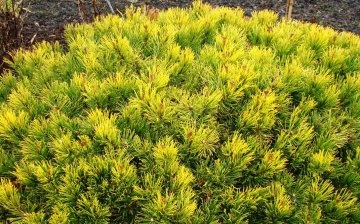
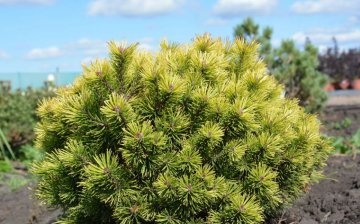
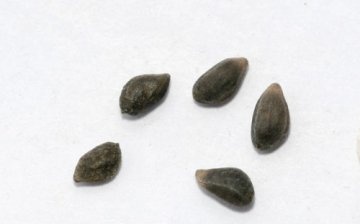
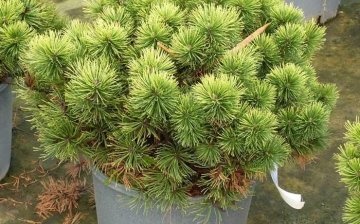
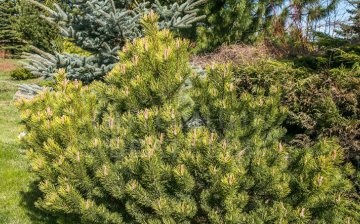
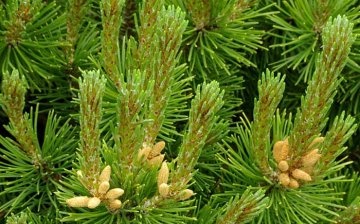
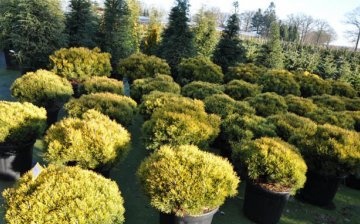
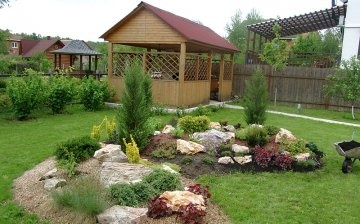








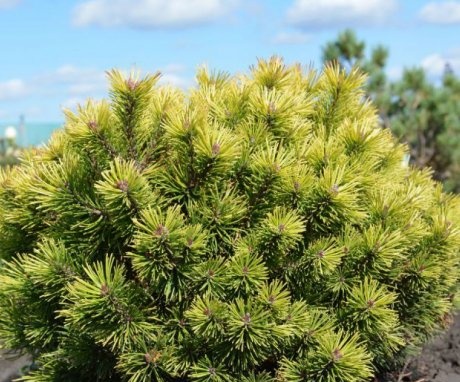
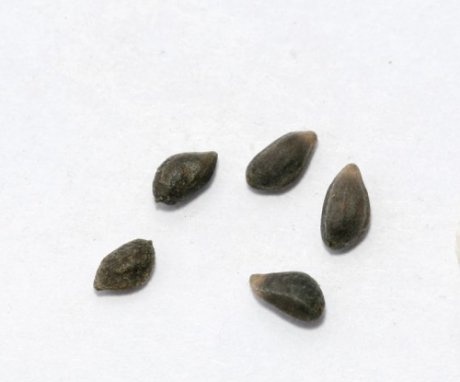
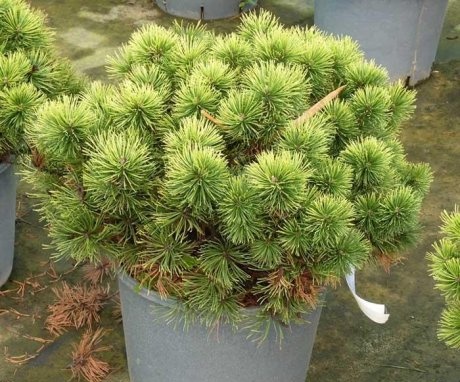
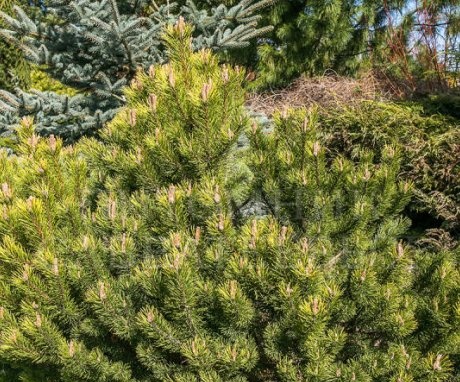
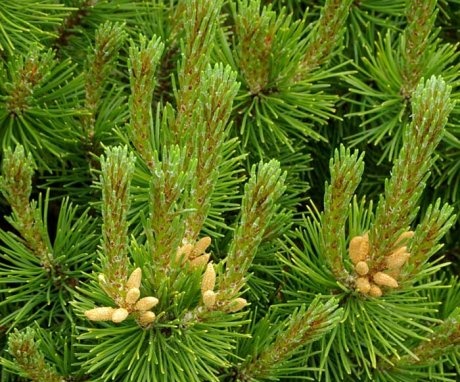
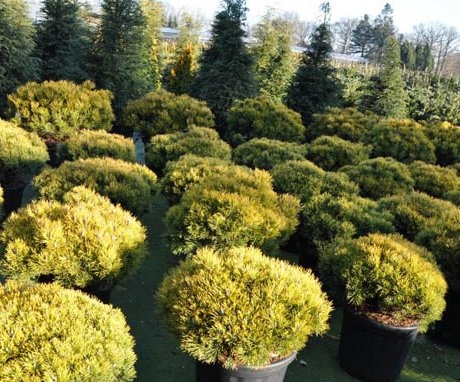

Coniferous asthenia really looks very beautiful in landscape design and goes well with many plants. I like that they are equally beautiful in winter and in summer. But in our region, not all pines take root. I have not seen this kind.